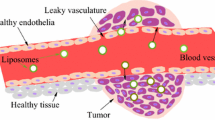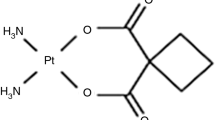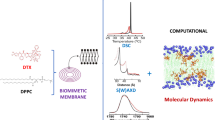Abstract
Purpose
The inhibitors of the human isoform 5 of lactate dehydrogenase (hLDH5) have attracted growing interest as efficient anti-cancer agents. In the present paper, the interactions between an efficient hLDH5 inhibitor (N-hydroxyindole-2-carboxylic derivative) and lipid bilayers based on dipalmitoylphosphatidylcholine (DPPC) were investigated. Additionally, since interstitial acidification plays a key role in tumor pathogenesis and tumor drug therapy, the effect of acidic pH was assessed and correlated to DPPC/drug interaction.
Methods
Four different techniques were used: differential scanning calorimetry, dynamic light scattering, UV-VIS second derivative spectrometry and attenuated total reflection Fourier transformed infrared spectroscopy.
Results
All techniques concur in highlighting a structural change of lipid assembly, susceptible both to pH change and to the presence of the antitumor compound. Lipid vesicles appeared more compact at the lower pH, since the thermal pre-transition from the lamellar gel phase to the ripple gel phase was absent at pH 7.4 and the infrared analysis revealed a stronger acyl chain packing as well as a different hydration degree. Drug interaction was mainly detected in the lipid region including the ester linkages and the first portion of the acyl chains. Furthermore, a lower drug partitioning was recorded at pH 6.6.
Conclusions
The investigated antitumor agent possesses a stable negative charge at the investigated pH values, thus the lower interaction at the acidic pH is mainly ascribable to an environmental effect on lipid assembly. Therefore, drug efficacy under tumor acid conditions may be hampered by the observed lipid membrane constraints, and suggest for the development of suitable prodrugs.





Similar content being viewed by others
Abbreviations
- ATR-FTIR:
-
Attenuated total reflection Fourier transformed infrared spectroscopy
- Chol:
-
Cholesterol
- DLS:
-
Dynamic light scattering
- DPPC:
-
1,2-dipalmitoyl-sn-glycero-3-phosphocholine
- DSC:
-
Differential scanning calorimetry
- F21:
-
1-Hydroxy-6-phenyl-4-(trifluoromethyl)-1Hindol-2-carboxylic acid
- hLDH5:
-
Human isoform 5 of lactate dehydrogenase
- PL:
-
Phospholipids
References
Wojtkowiak JW, Verduzco D, Schramm KJ, Gillies RJ. Drug resistance and cellular adaptation to tumor acidic pH microenvironment. Mol Pharm. 2011;8(6):2032–8. https://doi.org/10.1021/mp200292c.
Kolosenko I, Avnet S, Baldini N, Viklund J, De Milito A. Therapeutic implications of tumor interstitial acidification. Semin Cancer Biol. 2017;43:119–33. https://doi.org/10.1016/j.semcancer.2017.01.008.
Bilge D, Sahin I, Kazanci N, Severcan F. Interactions of tamoxifen with distearoyl phosphatidylcholine multilamellar vesicles: FTIR and DSC studies. Spectrochim Acta A Mol Biomol Spectrosc. 2014;130:250–6. https://doi.org/10.1016/j.saa.2014.04.027.
Do TTT, Dao UPN, Bui HT, Nguyen TT. Effect of electrostatic interaction between fluoxetine and lipid membranes on the partitioning of fluoxetine investigated using second derivative spectrophotometry and FTIR. Chem Phys Lipids 2017;207(Pt A):10–23. doi:https://doi.org/10.1016/j.chemphyslip.2017.07.001.
Pignatello R, Musumeci T, Basile L, Carbone C, Puglisi G. Biomembrane models and drug-biomembrane interaction studies: involvement in drug design and development. J Pharm Bioallied Sci. 2011;3(1):4–14. https://doi.org/10.4103/0975-7406.76461.
Granchi C, Roy S, Giacomelli C, Macchia M, Tuccinardi T, Martinelli A, et al. Discovery of N-hydroxyindole-based inhibitors of human lactate dehydrogenase isoform A (LDH-A) as starvation agents against cancer cells. J Med Chem. 2011;54(6):1599–612. https://doi.org/10.1021/jm101007q.
Granchi C, Calvaresi EC, Tuccinardi T, Paterni I, Macchia M, Martinelli A, et al. Assessing the differential action on cancer cells of LDH-A inhibitors based on the N-hydroxyindole-2-carboxylate (NHI) and malonic (Mal) scaffolds. Org Biomol Chem. 2013;11(38):6588–96. https://doi.org/10.1039/c3ob40870a.
Maftouh M, Avan A, Sciarrillo R, Granchi C, Leon LG, Rani R, et al. Synergistic interaction of novel lactate dehydrogenase inhibitors with gemcitabine against pancreatic cancer cells in hypoxia. Br J Cancer. 2014;110(1):172–82. https://doi.org/10.1038/bjc.2013.681.
Daniele S, Giacomelli C, Zappelli E, Granchi C, Trincavelli ML, Minutolo F, et al. Lactate dehydrogenase-A inhibition induces human glioblastoma multiforme stem cell differentiation and death. Sci Rep. 2015;5:15556. https://doi.org/10.1038/srep15556.
Chetoni P, Monti D, Tampucci S, Matteoli B, Ceccherini-Nelli L, Subissi A, et al. Liposomes as a potential ocular delivery system of distamycin A. Int J Pharm. 2015;492(1–2):120–6. https://doi.org/10.1016/j.ijpharm.2015.05.055.
Omran AA. An in vitro spectrometric method for determining the partition coefficients of non-steroidal anti-inflammatory drugs into human erythrocyte ghost membranes. Spectrochim Acta A Mol Biomol Spectrosc. 2013;104:461–7. https://doi.org/10.1016/j.saa.2012.12.002.
Hata T, Matsuki H, Kaneshina S. Effect of local anesthetics on the bilayer membrane of dipalmitoylphosphatidylcholine: interdigitation of lipid bilayer and vesicle-micelle transition. Biophys Chem. 2000;87:25–36.
Riske KA, Barroso RP, Vequi-Suplicy CC, Germano R, Henriques VB, Lamy MT. Lipid bilayer pre-transition as the beginning of the melting process. Biochim Biophys Acta Biomembr. 2009;1788(5):954–63. https://doi.org/10.1016/j.bbamem.2009.01.007.
Malekar SA, Sarode AL, BachII AC, Worthen DR. The localization of phenolic compounds in liposomal bilayers and their effects on surface characteristics and colloidal stability. AAPS PharmSciTech. 2016;17:1468–76.
Cevc G. How membrane chain melting properties are regulated by the polar surface of the lipid bilayer. Biochemistry. 1987;26:6305–10.
Mantsch HH, Chapman D, editors. Infrared spectroscopy of biomolecules. New York: Wiley-Liss; 1996.
Casal HL, Martin A, Mantsch HH. Infrared spectroscopic characterization of the interaction of lipid bilayers with phenol, salicylic acid and o-acetylsalicylic acid. Chem Phys Lipids. 1987;43:47–53.
Tsai YS, Ma SM, Nishimura S, Ueda I. Infrared spectra of phospholipid membranes: interfacial dehydration by volatile anesthetics and phase transition. Biochim Biophys Acta. 1990;1022(2):245–50. https://doi.org/10.1016/0005-2736(90)90120-d.
Cieślik-Boczula K, Maniewska J, Grynkiewicz G, Szeja W, Koll A, Hendrich AB. Interaction of quercetin, genistein and its derivatives with lipid bilayers – an ATR IR-spectroscopic study. Vib Spectrosc. 2012;62:64–9. https://doi.org/10.1016/j.vibspec.2012.05.010.
Kitamura K, Goto T, Kitade T. Second derivative spectrophotometric-Kitamura. Talanta. 1998;46:1433–8.
Wishart DS, Tzur D, Knox C, Eisner R, Guo AC, Young N, et al. HMDB: the human metabolome database. Nucleic Acids Res. 2007;35(Database issue):D521–6. https://doi.org/10.1093/nar/gkl923.
Wishart DS, Knox C, Guo AC, Eisner R, Young N, Gautam B, et al. HMDB: a knowledgebase for the human metabolome. Nucleic Acids Res. 2009;37(Database issue):D603–10. https://doi.org/10.1093/nar/gkn810.
Wishart DS, Jewison T, Guo AC, Wilson M, Knox C, Liu Y, et al. HMDB 3.0--the human metabolome database in 2013. Nucleic Acids Res. 2013;41(Database issue):D801–7. https://doi.org/10.1093/nar/gks1065.
Bykov EE, Lavrenov SN, Preobrazhenskaya MN. Quantum-chemical investigation of the dependence of pKa on the calculated energy of proton removal for certain derivatives of indole and phenol. Chem Heterocycl Compd. 2006;42(1):42–4. https://doi.org/10.1007/s10593-006-0044-z.
Smith EA, Dea PK. Differential scanning calorimetry studies of phospholipid membranes: the interdigitated gel phase. In: Elkordy AA, editor. Applications of calorimetry in a wide context-differential scanning calorimetry, isothermal titration calorimetry and microcalorimetry. Rijeka: InTech; 2013. p. Ch. 18.
Perez-Isidoro R, Sierra-Valdez FJ, Ruiz-Suarez JC. Anesthetic diffusion through lipid membranes depends on the protonation rate. Sci Rep. 2014;4:7534. https://doi.org/10.1038/srep07534.
Cinelli S, Onori G, Zuzzi S, Bordi F, Cametti C, Sennato S, et al. Properties of mixed DOTAP-DPPC bilayer membranes as reported by differential scanning calorimetry and dynamic light scattering measurements. J Phys Chem B. 2007;111(33):10032–9. https://doi.org/10.1021/jp071722g.
Claessens MM, van Oort BF, Leermakers FA, Hoekstra FA, Cohen Stuart MA. Charged lipid vesicles: effects of salts on bending rigidity, stability, and size. Biophys J. 2004;87(6):3882–93. https://doi.org/10.1529/biophysj.103.036772.
Lucero A, Rodríguez Niño M, Gunning A, Morris V, Wilde P, Rodríguez Patino J. Effect of hydrocarbon chain and pH on structural and topographical characteristics of phospholipid monolayers. J Phys Chem B. 2008;112:7651–61.
Briuglia ML, Rotella C, McFarlane A, Lamprou DA. Influence of cholesterol on liposome stability and on in vitro drug release. Drug Deliv Transl Res. 2015;5:231.
Kraft JC, Freeling JP, Wang Z, Ho RJY. Emerging research and clinical development trends of liposome and lipid nanoparticle drug delivery systems. J Pharm Sci. 2014;103(1):29–52.
Tan LT-H, Chan K-G, Pusparajah P, et al. Targeting membrane lipid a potential Cancer cure? Front Pharmacol. 2017;8:12.
Acknowledgments and Disclosures
The research project was supported by Progetti di ricerca di Ateneo PRA 2017 of the University of Pisa.
Author information
Authors and Affiliations
Corresponding author
Rights and permissions
About this article
Cite this article
Monti, D., Tampucci, S., Zucchetti, E. et al. Effect of Tumor Relevant Acidic Environment in the Interaction of a N-hydroxyindole-2-Carboxylic Derivative with the Phospholipid Bilayer. Pharm Res 35, 175 (2018). https://doi.org/10.1007/s11095-018-2449-7
Received:
Accepted:
Published:
DOI: https://doi.org/10.1007/s11095-018-2449-7




